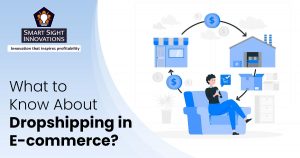 Setting up a business is simpler than ever because of the internet. All you need is a concept, a supplier and a website to sell a good or service online with minimal trouble, leading to a significant expansion of the e-commerce industry. In the fourth quarter of 2021, U.S. retail e-commerce increased by 10.4% and by 2027, it is projected to generate more than 1.7 trillion dollars.
Setting up a business is simpler than ever because of the internet. All you need is a concept, a supplier and a website to sell a good or service online with minimal trouble, leading to a significant expansion of the e-commerce industry. In the fourth quarter of 2021, U.S. retail e-commerce increased by 10.4% and by 2027, it is projected to generate more than 1.7 trillion dollars.
What Is Dropshipping?
Dropshipping is a method of e-commerce where a seller provides (goods) by direct delivery from the manufacturer to the retailer or customer. This typically involves the seller setting up a website to sell products that the seller does stock. When an order is placed, the seller sends this order to a third party — the manufacturer, another retailer, or a wholesaler — who fulfills the order by shipping the goods directly to the buyer.
In other words, the supplier receives the sales order from the seller and fulfills it. The seller often purchases the item at a lower cost from the manufacturer or wholesaler and sells it at a higher pre-listed price. The profit comes from the price difference between the original cost of the item and the price at which it is sold.
Dropshipping is becoming increasingly popular and more and more companies act as middlemen and provide services like data, automation, links and access to wholesale suppliers to help you run your online business. In dropshipping, the vendor sends the items directly to the buyer after fulfilling orders from a third party.
It can be overwhelming to discover the best wholesale suppliers with excellent products for your clients in the beginning. The merchant neither stores the inventory nor sends out shipments. They instead focus mostly on managing their online presence, marketing and advertising. More than 33% of online retailers use dropshipping to supply their product demand because it is very effective.
The Pros and Cons of Dropshipping
Dropshipping is a simple approach for potential business owners to get started in e-commerce. You will also benefit from the trends of consumers favoring e-commerce over physical stores. Though dropshipping has a lot of flexibility, there are several drawbacks too. Explore the pros and cons of dropshipping to determine if this business strategy is suitable for you.
Pros of Dropshipping
1. Minimal startup costs
Dropshipping allows you to start your store without spending all of your savings. It does not require upfront product purchases or inventory investments. A significant portion of the normal expenses that traditional sellers bear is eliminated by the dropshipping approach.
2. No requirement for a storage space
Dropshipping eliminates the need for you to lease and operate a warehouse or pack and ship orders because you are not in the business of selling physical goods. Brands that don’t want to invest in a huge inventory or operate a warehouse can consider dropshipping.
3. Minimal staff requirement
As you do not have to deal with inventory or manage a warehouse, your overhead expense as a dropshipper is negligible. Many dropshipping companies are run as home-based businesses.
4. Worldwide reach
With an Internet connection, a dropshipping business can be operated from almost anywhere. As long as you can easily connect with suppliers and clients, you can manage your business. This makes dropshipping easily accessible to businesses.
5. Wide range of products
Since the stuff you sell doesn’t have to be pre-purchased, you can give your potential consumers a wide selection of trending items. If suppliers have stock of a product, you can make it available for purchase in your online store at no extra cost.
6. Easy to scale
A traditional retail business may require you to put in extra effort to scale. But dropshipping ensures the suppliers will handle the majority of the work required to complete more orders, allowing you to grow with fewer challenges without requiring too much effort.
7. Third-party shipping
The major advantage of dropshipping is that you don’t have to bother about keeping and transporting your product. Once a customer buys a product from you, your supplier takes care of the order. Despite this, you need to order product samples and assess the quality of each item, to ensure that products are of acceptable quality.
Cons of Dropshipping
1. No control over the supply chain
Your ability to fulfill customer orders will be impacted by the stock levels of your suppliers. If the supplier runs out of stock you might need to temporarily stop selling their products resulting in longer lead times and lost clients. Even if you follow all the rules, the company may still be in danger if the supplier doesn’t live up to their end of the contract.
2. Maintaining quality is challenging
When you offer to dropship, you are unable to check things and ensure they correspond to the descriptions. If quality control is weak, it could be difficult to meet client expectations. When it comes to issues like late delivery, damaged goods and inaccurate or missing items, customers will come back to you rather than contacting the supplier.
For circumstances beyond your control, a single bad batch of goods could lead to disgruntled customers, lost sales and potentially poor customer feedback.
3. Establishing a brand can be difficult
Dropshipping does not give you much room to customize a customer’s product. There isn’t much you can do about it as you order these products from the suppliers. But you can work towards building your brand name with a well-designed website and an excellent product description that includes pictures and videos.
4. Lack of customer service
It may be fortunate that you do not have to handle inventory management. But that is until you have customers complaining about the products. Playing the role of a middleman makes you responsible for the supplier’s failures. To prevent receiving negative reviews, be prepared to genuinely apologize and offer excellent customer service.
5. Fierce competition
Dropshipping is attractive as it costs very little to begin, leading to intense competition. You may run into various businesses selling the same products from the same producers. This means customers may be able to save money by buying a product from someone else. A company can lower its costs to attract customers only if its profits are high. This makes it difficult for small businesses to obtain clients.
6. Low margins of profit
The volume of traffic that your website receives has a significant impact on the success of your dropshipping business. If you’re establishing an e-commerce firm from scratch, you could find it difficult to attract customers initially. If you wish to increase your profit, you will have to create a credible business. A credible brand name will increase the chances of customers’ willingness to pay more for your products.
7. Refunds and returns
As you are the one representing the brand, refunds and returns become your responsibility even though you might have not shipped or packed that item. And if you fail to deal with it professionally, it might lead to an unpleasant situation for you as well as your customer. Clearly communicating your refund, return, and replacement policies can help you manage these situations effectively.
8. Shipping difficulties
Calculating the shipping expenses is simple if you buy your products from one provider. But, dropshippers generally work with multiple suppliers for various products and calculating shipping costs becomes hard. Additionally, suppliers may have different systems of shipping. To make things easier, dropshippers can start with one provider and then scale up once they get a grip on their business.
Despite these probable drawbacks, dropshipping is still considered profitable. Forecasts indicate that by 2025, the size of the global dropshipping market will increase by 28.8% annually, which means the market will be worth $557.9 billion.
Dropshipping operations can be protected and delivery times can be accelerated by expanding the network of warehouses to store goods. As there is no geographical limitation, you can sell in any market. Once you have established your brand you can expand your business and start your global journey.













